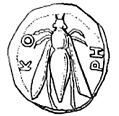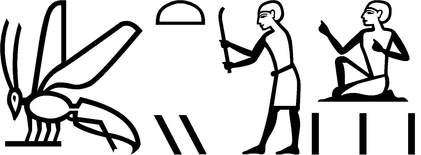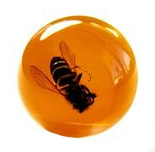|
THE HISTORY OF THE BEE
In Ancient Egypt, the honeybee was one of several royal symbols, and was used consistently for over four thousand years. The bee represented the Pharaoh's sovereignty over Lower Egypt and the Pharaoh was often referred to as 'He (or She) of the Sedge and Bee'. To the Ancient Egyptians, the Pharaoh was a God King, and this association between Bees and Deities seems to be as old as religion itself. Bees were supposedly born from the tears of the Sun God, Ra. The Temple of Neith, the goddess of the night, was known as 'The House of the Bee' and the sanctuary of Osiris, god of the underworld, was 'The Mansion of the Bee'.
In one Ancient Egyptian ritual in The Book of Am-Tuat, the voice of the soul is compared to the humming buzz of bees and in another ritual, Kher-Heb, the soul is referred to as 'going about as a bee, though seeest all the goings about'. Intriguingly, Northern Egypt – the land stretching form the Delta to Memphis was known as “Ta-Bitty”, or “the land of the bee”. Similarly in the bible, the Lord promises to bring the Israelites out of Egypt and into a land flowing with milk and honey. 
In Ancient Greece the priestesses who attended the Goddess Demeter were known as Melissae meaning 'bees'. This name of Melissae for priestesses is also used by several modern Goddess groups to honour bees and their Goddess as their 'Queen Bee'. The original Melissa was a Greek Nymph who came to care for the infant Zeus, shielding from his father Cronus who intended to eat every one of his offspring. As punishment for protecting Zeus, Cronos turned Melissa into an earthworm; later the adult Zeus took pity on her and changed her into a bee.
Bees of all kinds were thought to have special knowledge and the ability to tell or see into the future. In Greek mythology the God Apollo was taught how to see into the future by the Thriae: the three pre-Hellenic Bee Goddesses, Melaina, Kleodora and Daphnis. If a bee buzzes over a sleeping child in its cot it is said to portend that the child will live a long, happy, healthy and prosperous life and if the bee touched the child's lips it would be a great poet according to Greek folklore. There was also a ritual called bugonia based on the belief that bees were spontaneously generated from a bull's carcass, although it is possible that the ritual had more currency as a poetic and learned trope than as an actual practice. Aristaeus, a minor god credited with introducing beekeeping, performed bugonia when his bees began to die from sickness. “The bee inclos’d, and through the amber shewn,
Seems buried in the juice, which was his own. So honour’d was a life in labor spent: Such might he wish to have his monument.” – Marcus Valerius Martialis In Africa, Bantu tribes lived in Beehive shaped houses – as did Zulu tribes, amongst many others, and Bees were common symbols on totem poles. The Dogon, a tribe from the West African region of Mali, have an ancient belief system, and until approximately 140 AD, its zodiac featured the Bee as the symbol of the constellation presently occupied by Libra. The Bee’s position in the Dogon Zodiac is significant to esoteric thought leaders such as Cabalists, who recognize the Bee’s role in establishing balance and harmony in the zodiac – and in life. Curiously, two of the most common Dogon symbols resemble schematized figures identified by Marija Gimbutas as Bees; one is associated with vital food supplies and the other with reincarnation. Together, the Dogon images reflect the essence of the Bee’s perceived value in ancient times.
Ethiopians have a saying that Christ; “is born from the voice of his father, like the bee is born from the Queen” and believe that the Bee once defended the throne of God. The Vikings of Scandinavia were famously bee-keepers and one of their main exports was mead. Skep or skeppa is an old Norse word for bushel or basket, hence the skep beehives some still use today. The bees would be smoked from the skep and the honey and comb removed. The remains of the hive would be doused in boiling water to dissolve the wax comb and honey. In Viking mythology, honey mead was one of the main ingredients, along with the blood of Kvasir, of the Mead of Poetry, a magical brew that could give the gifts of wisdom and poetry and immortality to anyone who drank it.
The tradition of the Bee worship in Spain has been preserved to this day, albeit under the rather macabre guise of Bull fighting. The modern day ‘sport’ is actually an extension of Mithraism, the ancient mystery school whose rites included the ritualistic slaughter of bulls.
In Lithuania, the Bee goddess was known as Austheia, and legend asserts that when the Queen Bee left the hive in search of a new home, families would pack up and follow the Queen’s swarm until the Bees established a new hive, and any families united as a result of the exodus were bound together in a special relationship called ‘biciulyste’. Austheia’s husband was a Bee god named Bubilas, as well as a household god who Lithuanians honoured with honey in hope that the Bees will swarm more effectively – in other words, in the direction of their tree trunk and not their neighbours! The Bee and its by-products were considered gifts in Lithuania, and thus neither Bees nor honey could be bought or sold, as was and still is true in many cultures. Additionally, it was considered improper to leave a dead bee unburied, and if one was discovered, it was expected that one stopped what he or she was doing and bury it in the earth immediately.
For a bit more bee mythology, see here...
|
TELLING THE BEES
The telling of the bees is a traditional European custom in which bees would be told of important events in their keeper's lives, such as births, marriages, or departures and returns in the household. If the custom was omitted or forgotten and the bees were not "put into mourning" then it was believed a penalty would be paid, such as the bees might leave their hive, stop producing honey, or die.
Following a death in the household, there are several ways in which bees were to be informed and therefore put into proper mourning. One approach from England would require the "goodwife of the house" to "hang the stand of hives with black, the usual symbol of mourning, she at the same time softly humming some doleful tune to herself." The bees could also be invited to the funeral.In cases where the beekeeper had died, food and drink from the funeral would also be left by the hive for the bees, including the funeral biscuits and wine. The hive would also be lifted a few inches and put down again at the same time as the coffin. The hive might also be rotated to face the funeral procession, and draped with mourning cloth. In some parts of the Pyrenees, one custom includes "burying an old garment belonging to the deceased under the bench where the bee-hives stand, and they never sell, give away, nor exchange the bees of the dead." Should the bees fail to be told of a death in the family, "serious calamity" would follow not only for the family in question, but also for any person who was to buy the hive. For example, one record from Norfolk tells of a family who bought a hive of bees at auction from a farmer who had recently died and, because the bees had not been "put into mourning for their late master" they were "sickly, and not likely to thrive." However, when the new owners tied a "piece of crepe" to a stick and attached it to the hive, the bees soon recovered, an outcome that was "unhesitatingly attributed to their having been put into mourning." Although the practice of telling the bees is most commonly associated with funerals, there are also certain regions in which the bees are to be told of happy events of the family, particularly weddings. In Germany, one custom held that newly married couples going to their new home must first introduce themselves to the bees or else "their married life will be unfortunate." A 1950s article in the Dundee Courier Scotland, describes the practice of inviting bees to the wedding. If a wedding occurred in the household, the hive might be decorated, and a slice of wedding cake left by their hive. The decoration of hives appears to date to the early 19th century. One tradition in Brittany held that unless bee hives were decorated with scarlet cloth at a wedding and the bees allowed to partake in the rejoicing, they would go away. "Before them, under the garden wall,
Forward and back Went, drearily singing, the chore-girl small, Draping each hive with a shred of black. Trembling, I listened; the summer sun Had the chill of snow; For I knew she was telling the bees of one Gone on the journey we all must go! "Stay at home, pretty bees, fly not hence! Mistress Mary is dead and gone!" – from John Greenleaf Whittier's poem "Home Ballads" SYMBOLISM
Bees generally symbolise wealth, the wealth of knowledge or the wealth of good luck as well as meaning wealth in the financial sense. It's thought you must never buy bees with normal money, only with gold coins, although, if possible, it is best to barter over them, so as not to offend them, or to receive them as a gift, so that no money changes hands at all. There is an odd belief that virgins can pass through a swarm of bees without being stung and if bees nested in the eaves of a house it was said that the daughters of the house would never marry.
In Wales, it was very lucky if bees of any kind set up home in or near your home, as they were said to bless it with prosperity. Should a bee land in your hand then it allegedly means that money is coming your way. If a single bee enters your house it is traditionally a sign of good luck coming to you, usually in the form of money. If a bumblebee buzzes around your house or at your window, it brings news that a visitor will soon arrive, and the bumblebee is even supposed to tell you the visitor's gender; if it has a red tail (like the Early Bumblebee or Red-tailed Bumblebee) the visitor will be male, if the tail is white (as with the White-Tailed Bumblebee, Heath Bumblebee or Garden Bumblebee), the visitor will be female. However if anyone killed the visiting bumblebee, the visitor would bring nothing but bad news (which serves them right)! Even in modern folk magic bumblebees serve as a as a charm for health and wealth. Bee stings were said to treat the pain of rheumatism and arthritis (something modern science is investigating), and honey has been used in folk magic to treat just about any and every ailment mankind has ever been known to suffer with. There was an old folk charm, found in Dawlish, that sadly featured three dead bumblebees in the bag. Bees have long been associated with witches and witchcraft: one Lincolnshire witch was said to have a bumblebee as her familiar, another witch from Scotland allegedly poisoned a child in the form of a bee, and in Nova Scotia a male witch was accused of killing a cow by sending a white bumblebee to land on it. Bees are said to be able to predict the weather, as in the rhymes below: 'When bees to distance wing their flight
Days are warm and skies are bright But when their flight ends near their home Stormy weather is sure to come.' 'A swarm of bees in May
Is worth a load of hay; A swarm of bees in June Is worth a silver spoon; A swarm of bees in July Is not worth a fly.' Bee dreams have a myriad of meanings depending on what the bees in your dream are doing. If they swarm, it suggests that you will be overwhelmed or experience bad luck. To dream of being stung is to be betrayed by someone you know. However if you dream of bees happily buzzing, then the dream augurs good fortune for the day ahead.
|



